

面试题:三个线程按顺序打印 ABCABC
source link: https://www.51cto.com/article/740119.html
Go to the source link to view the article. You can view the picture content, updated content and better typesetting reading experience. If the link is broken, please click the button below to view the snapshot at that time.
面试题:三个线程按顺序打印 ABCABC
小伙伴们好呀,最近在重新复习,整理自己的知识库,偶然看到这道面试题:三个线程按顺序打印 ABCABC,尝试着做一下,才发现自己对线程还有好多地方不懂,蓝瘦…… 🐷
很明显,这里就涉及线程间相互通信的知识了。
而相互通信的难点就是要控制好,阻塞和唤醒的时机。
一. 这里就是 A 通知 B,B 通知 C , C 通知 A
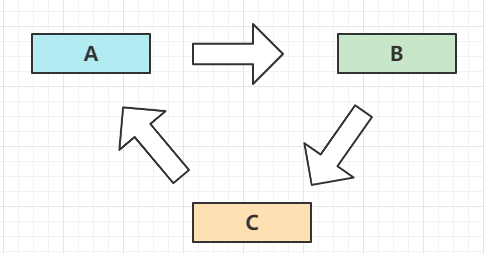
二. 三个线程在等待(阻塞)和唤醒(执行) 中不断切换。
三. 等待的方式大致分为两种
- wait 方法 (Object native 方式 )
- LockSupport.park 方式 ( Unsafe native 方式 )
四. 唤醒的方式
- notify,notifyAll 方法 (Object native 方式 )
- LockSupport.unPark 方式 ( Unsafe native 方式 )
五. 互斥条件
线程 A 先拿到资源 c,再拿资源 a ,[a 执行完后释放,并唤醒等待资源 a] 的 线程 B 线程 B 先拿到资源 a,再拿资源 b ,[b 执行完后释放,并唤醒等待资源 b] 的 线程 C 线程 C 先拿到资源 b,再拿资源 c ,[c 执行完后释放,并唤醒等待资源 c] 的 线程 A
所以得有 三个 共享资源 abc 来达到互斥条件
Synchronized 还是 ReentrantLock 都得建立 三个共享资源
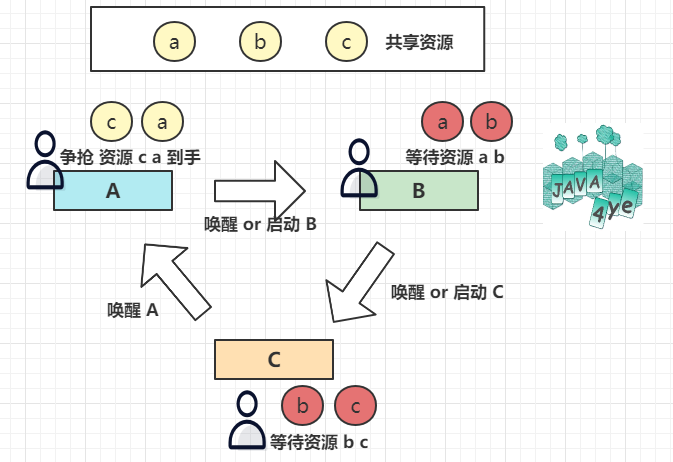
使用 LockSupport ,如果要像上面这样子的思路去解答,就得注意 线程相互引用行成的循环依赖问题,这里借用 Spring 的思路 用 Map 巧妙化解。
或者做法2 通过 外部的成员变量,不断地去判断,unpark 线程 a b c
Synchronized 方式
private static class MySynchronized {
void printABC() throws InterruptedException {
class MyRunable implements Runnable {
private Object lock1;
private Object lock2;
private CountDownLatch countDownLatch;
public MyRunable(Object lock1, Object lock2){
this.lock1 = lock1;
this.lock2 = lock2;
}
public MyRunable(Object lock1, Object lock2, CountDownLatch countDownLatch){
this.lock1 = lock1;
this.lock2 = lock2;
this.countDownLatch = countDownLatch;
}
@Override
public void run(){
boolean running = false;
int count = 2;
while (count > 0) {
// C,A - > A 唤醒 B 线程
// A,B - > B 唤醒 C 线程
// B,C - > C 唤醒 A 线程 (最后一次执行时,唤醒 A 后,A 发现 count =0,就不执行了。
synchronized (lock1) {
synchronized (lock2) {
System.out.println(Thread.currentThread().getName());
count--;
// lock2 方法块执行结束前,唤醒其他线程。
lock2.notify();
}
// 线程执行完毕后
if (countDownLatch != null && !running) {
countDownLatch.countDown();
running = true;
}
try {
// 释放锁
lock1.wait();
} catch (InterruptedException e) {
}
}
}
System.out.println(Thread.currentThread().getName() + " over");
synchronized (lock2) {
// 唤醒其他线程。
lock2.notify();
}
}
}
CountDownLatch countDownLatch = new CountDownLatch(1);
CountDownLatch countDownLatch2 = new CountDownLatch(1);
Object a = new Object();
Object b = new Object();
Object c = new Object();
MyRunable ra = new MyRunable(c, a, countDownLatch);
MyRunable rb = new MyRunable(a, b, countDownLatch2);
MyRunable rc = new MyRunable(b, c);
Thread a1 = new Thread(ra, "A");
a1.start();
countDownLatch.await();
Thread b1 = new Thread(rb, "B");
b1.start();
countDownLatch2.await();
Thread c1 = new Thread(rc, "C");
c1.start();
}
}这里我借用 countDownLatch 去控制线程的启动流程,尽量不使用 Thread.sleep() 来实现,拿捏线程的执行,通信步骤。
写这个的时候,除了一开始思路不清晰外,还出现一个小状况,就是 程序执行完卡住了。
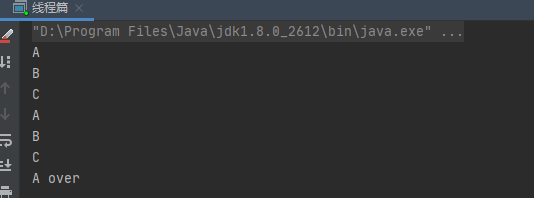
debug 发现线程 B C 还在 wait 状态,这是写时候容易疏忽的。
要记得在循环外再次唤醒其他线程,让他们走完方法。
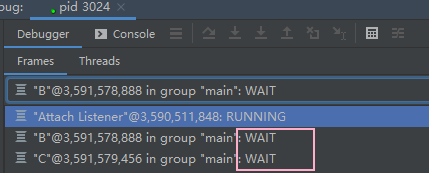
ReentrantLock 方式
private static class MyReentrantLock {
int number = 6;
void printABC(){
ReentrantLock lock = new ReentrantLock();
Condition conditionA = lock.newCondition();
Condition conditionB = lock.newCondition();
Condition conditionC = lock.newCondition();
class MyRunnable implements Runnable {
ReentrantLock lock;
Condition condition1;
Condition condition2;
public MyRunnable(ReentrantLock lock, Condition condition1, Condition condition2){
this.lock = lock;
this.condition1 = condition1;
this.condition2 = condition2;
}
@Override
public void run(){
int count = 2;
while (count > 0) {
lock.lock();
try {
String name = Thread.currentThread().getName();
if (
number % 3 != 0 && "A".equals(name)
|| number % 3 != 2 && "B".equals(name)
|| number % 3 != 1 && "C".equals(name)
) {
condition1.await();
}
System.out.println(name + " : " + number);
number--;
count--;
condition2.signal();
} catch (InterruptedException e) {
e.printStackTrace();
} finally {
lock.unlock();
}
}
}
}
new Thread(new MyRunnable(lock, conditionC, conditionA), "A").start();
new Thread(new MyRunnable(lock, conditionA, conditionB), "B").start();
new Thread(new MyRunnable(lock, conditionB, conditionC), "C").start();
}
}Synchronized 会了之后,这个也很简单了。
就是上锁的地方换成 lock.lock();,把三个共享资源换成 lock.newCondition();
然后思考一下阻塞条件 condition1.await() 。
毕竟 打印 和 唤醒 的操作总是在一起的。
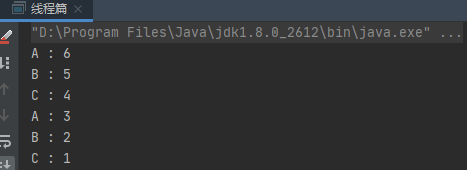
Semaphore 我也写了,但是感觉不太适合,毕竟它的作用是用来控制并发线程数的,我直接创建三个 Semaphore 总觉得怪怪的。🐖
LockSupport 方式
这里我写了两种方法
private static class MyLockSupport {
volatile int number = 6;
void printABC() throws InterruptedException {
class MyRunnable implements Runnable {
@Override
public void run(){
int count = 2;
while (count > 0) {
LockSupport.park(this);
System.out.println(Thread.currentThread().getName());
count--;
}
}
}
Thread a = new Thread(new MyRunnable(), "A");
Thread b = new Thread(new MyRunnable(), "B");
Thread c = new Thread(new MyRunnable(), "C");
a.start();
b.start();
c.start();
while (number > 0) {
if (number % 3 == 0) {
LockSupport.unpark(a);
} else if (number % 3 == 2) {
LockSupport.unpark(b);
} else {
LockSupport.unpark(c);
}
number--;
LockSupport.parkNanos(this, 200 * 1000);
// LockSupport.parkUntil(this,System.currentTimeMillis()+3000L);
}
}
// 用 map 解决线程循环依赖的问题
void printABC2() throws InterruptedException {
class MyRunnable implements Runnable {
Map<String, Thread> map;
public MyRunnable(Map<String, Thread> map){
this.map = map;
}
@Override
public void run(){
int count = 2;
String name = Thread.currentThread().getName();
String key = "A".equals(name) ? "B" : "B".equals(name) ? "C" : "A";
while (count > 0) {
if (
number % 3 == 0 && "A".equals(name)
|| number % 3 == 2 && "B".equals(name)
|| number % 3 == 1 && "C".equals(name)
) {
System.out.println(name);
count--;
number--;
LockSupport.unpark(map.get(key));
}
LockSupport.park(this);
}
LockSupport.unpark(map.get(key));
}
}
Map<String, Thread> map = new HashMap<>();
Thread a = new Thread(new MyRunnable(map), "A");
Thread b = new Thread(new MyRunnable(map), "B");
Thread c = new Thread(new MyRunnable(map), "C");
map.put("A", a);
map.put("B", b);
map.put("C", c);
a.start();
b.start();
c.start();
}
}LockSupport 我也是第一次用,它使用起来也很方便,就单纯的 阻塞和唤醒线程 ,对应 park 和 unPark 方法。
它不要求你像 wait 那样子,必须写在 Synchronized 代码块里,被 Monitor 监视才行。
但同时,也意味着你必须控制好这个 锁的范围 。
你可以自由阻塞代码,在具备某个条件时,唤醒特定的线程,让它继续执行。
实际上,上面 ReentrantLock 中的 Condition await 方法,底层就是调用 LockSupport 的 park 方法。
这也是我开头说的通信大致分为两种方式的原因。
方法一中,我是用 parkNanos 阻塞一段时间,然后就继续运行,也算是取巧不用 Thread.Sleep 了吧😝
方法二 我比较喜欢,思路也是同开头两种,打印完唤醒其他线程。
Recommend
About Joyk
Aggregate valuable and interesting links.
Joyk means Joy of geeK